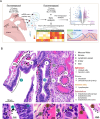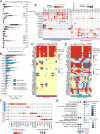A cell atlas of the human fallopian tube throughout the menstrual cycle and menopause
- PMID: 39753552
- PMCID: PMC11698969
- DOI: 10.1038/s41467-024-55440-2
A cell atlas of the human fallopian tube throughout the menstrual cycle and menopause
Abstract
The fallopian tube undergoes extensive molecular changes during the menstrual cycle and menopause. We use single-cell RNA and ATAC sequencing to construct a comprehensive cell atlas of healthy human fallopian tubes during the menstrual cycle and menopause. Our scRNA-seq comparison of 85,107 pre- and 46,111 post-menopausal fallopian tube cells reveals substantial shifts in cell type frequencies, gene expression, transcription factor activity, and cell-to-cell communications during menopause and menstrual cycle. Menstrual cycle dependent hormonal changes regulate distinct molecular states in fallopian tube secretory epithelial cells. Postmenopausal fallopian tubes show high chromatin accessibility in transcription factors associated with aging such as Jun, Fos, and BACH1/2, while hormone receptors were generally downregulated, a small proportion of secretory epithelial cells had high expression of ESR2, IGF1R, and LEPR. While a pre-menopausal secretory epithelial gene cluster is enriched in the immunoreactive molecular subtype, a subset of genes expressed in post-menopausal secretory epithelial cells show enrichment in the mesenchymal molecular type of high-grade serous ovarian cancer.
© 2025. The Author(s).
Conflict of interest statement
Competing interests: E.L. receives research funding to study ovarian cancer from Arsenal Bioscience and AbbVie through the University of Chicago unrelated to this work. All other authors declare no competing interest.
Figures






Update of
-
A Cellular atlas of the human fallopian tube reveals the metamorphosis of secretory epithelial cells during the menstrual cycle and menopause.medRxiv [Preprint]. 2023 Nov 23:2023.11.22.23298470. doi: 10.1101/2023.11.22.23298470. medRxiv. 2023. Update in: Nat Commun. 2025 Jan 3;16(1):372. doi: 10.1038/s41467-024-55440-2. PMID: 38045369 Free PMC article. Updated. Preprint.
References
-
- Rigby, C. H. et al. The immune cell profile of human fallopian tubes in health and benign pathology: a systematic review. J. Reprod. Immunol.152, 103646 (2022). - PubMed
-
- Crow, J., Amso, N. N., Lewin, J. & Shaw, R. W. Morphology and ultrastructure of fallopian tube epithelium at different stages of the menstrual cycle and menopause. Hum. Reprod.9, 2224–2233 (1994). - PubMed
Publication types
MeSH terms
Substances
Grants and funding
LinkOut - more resources
Full Text Sources
Medical
Research Materials
Miscellaneous

